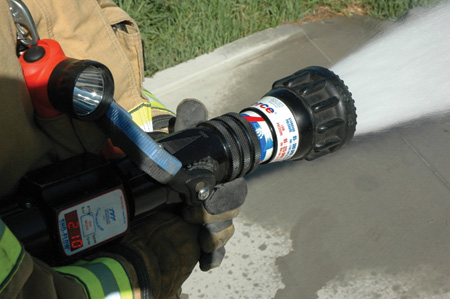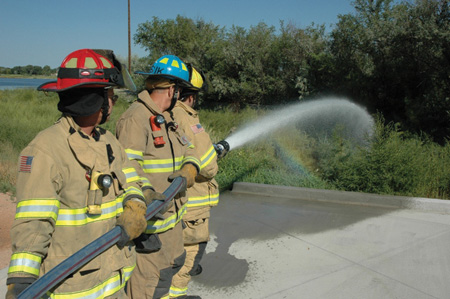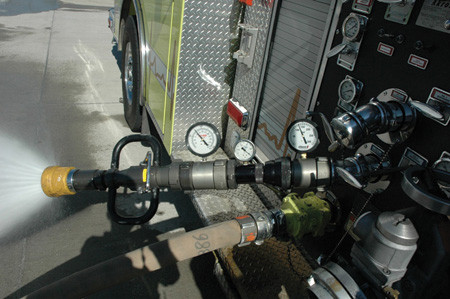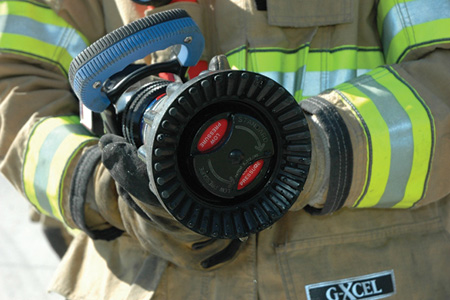
By BILL NEMICK
Have you ever been on the end of a hoseline when the water pressure was either too high or too low for the nozzle, resulting in a poor fire stream? Or, have you ever wanted to change the tip size or gallonage setting on the nozzle but decided not to because it was too difficult to communicate accurately with the pump operator? I have, and it can be quite frustrating. A solution to this problem exists that many firefighters discount because of a lack of a thorough understanding or a second- or third-hand story they once heard. This story involves a mysterious firefighter in another department (of course!) that had a catastrophic problem with this solution. This solution is a constant-pressure, variable-gallonage combination nozzle, better known as the automatic nozzle. I believe the automatic nozzle is a far better choice than the standard constant gallonage or adjustable gallonage nozzles.
 (1) The nozzle bail is fully open and flowing 140 gallons per minute (gpm) at 100 pounds per square inch (psi). (Photos by author.) (2) The nozzle bail is opened at around 50 percent and flowing 115 gpm at 100 psi. (3) The nozzle bail is opened at around 30 percent and is flowing 80 gpm at 100 psi. (1) The nozzle bail is fully open and flowing 140 gallons per minute (gpm) at 100 pounds per square inch (psi). (Photos by author.) (2) The nozzle bail is opened at around 50 percent and flowing 115 gpm at 100 psi. (3) The nozzle bail is opened at around 30 percent and is flowing 80 gpm at 100 psi. |
The Two Nozzles
First, let’s review the two other combination nozzle types: the “constant-gallonage” nozzle and the “adjustable-gallonage” nozzle. The constant gallonage nozzle is the simplest of these nozzles because it has a fixed orifice that is rated for a predetermined gallons per minute (gpm) at a standard nozzle pressure. This means that its rated pounds per square inch (psi) will produce a predetermined volume of water. This constant-gallonage nozzle has no adjustments on it that affect the volume of water being discharged. The pump operator is in complete control of this volume and only needs to know the rated nozzle pressure and the pressure loss in the hoseline to correctly supply the nozzle. The volume control for a constant-gallonage nozzle is similar in principle to that of a fixed orifice smooth bore nozzle.
The adjustable-gallonage nozzle is a modified constant gallonage nozzle with several orifice sizes that the nozzle operator can manually select. When the operator needs to change an adjustable gallonage nozzle’s volume, he rotates a collar on the nozzle, which manually changes the orifice size of the nozzle, similar to changing a tip on a smooth bore nozzle. Often, this is not a problem because many departments have a standard hose length and leave the nozzle at a standard gpm setting. In fact, some departments have labels next to the discharge gauges stating what the discharge pressure (DP) should be at these standard settings. This works well as long as the hose length or gpm setting is not changed. Problems occur when these predetermined settings are not appropriate for the situation. For example, if you have a poor fire stream or you want to change the volume setting from the “standard” setting, you must contact the pump operator and accurately communicate to him the desired changes. This may not be a problem during a defensive attack, but during an offensive interior attack, it can be extremely difficult and dangerous. Using an automatic nozzle would eliminate most, if not all, of these problems. Next, let’s review how an automatic nozzle works and how it could solve the above problems.
 |
 |
| (4, 5) The nozzle bail is fully opened and flowing 210 gpm at 55 psi. |
Automatic nozzles are very similar in principle to pressure relief valves and, in fact, the automatic nozzle is sometimes referred to as a constant-pressure nozzle. With a pressure relief valve, once the water pressure exceeds the selected pressure, it opens up just enough to relieve this excess pressure by discharging water through the valve. If the water pressure behind the valve increases, the discharge opening increases in a corresponding manner, discharging even more water. As a result, a constant pressure is maintained. For example, imagine a spring pushing a ball against the opening of a pipe. Now, if the water pressure in the pipe is 50 psi and the spring applies a constant pressure of 100 psi against the ball, the ball will be firmly seated against the opening of the pipe, and it will not discharge any water. If the water pressure in the pipe is increased, the ball will remain seated against the opening of the pipe until the pressure exceeds 100 psi. At this point, the water pressure will compress the spring and the ball and will be pushed away from the pipe, which will discharge just enough water to maintain 100 psi in the pipe. If the water pressure in the pipe falls below 100 psi, the ball will once again become seated and stop the water from discharging.
An automatic nozzle works much the same way except it is designed to shape and discharge any volume of water supplied-within its volume rating-into an effective fire stream. Once enough water is flowing to meet its minimum rating, the correct nozzle pressure will be achieved (typically 100 psi). If the pump operator increases the DP at the engine, the nozzle pressure will remain unchanged because the nozzle will automatically enlarge its opening, which in turn discharges more water. This characteristic is the reason the automatic nozzle is sometimes referred to as a “constant-pressure, variable-gallonage combination nozzle.”
 (6, 7) The nozzle bail is opened at around 50 percent and is flowing 155 gpm at 55 psi. (6, 7) The nozzle bail is opened at around 50 percent and is flowing 155 gpm at 55 psi. |
If you have an automatic nozzle that is rated at 70 to 200 gpm at 100 psi, the discharge opening is preset to flow 70 gpm at 100 psi. This discharge opening will not open any farther until more than 70 gpm of water is flowing through it. Once 70 gpm of water is flowing, the nozzle pressure will be at 100 psi. Now, when the pump operator increases the DP, it will cause the nozzle’s opening to increase in size, which will maintain a constant 100 psi nozzle pressure by discharging more water. The nozzle’s opening will continue to open and maintain 100 psi until it reaches the maximum rated volume of 200 gpm, at which time the nozzle is fully opened. Once the nozzle reaches 200 gpm, and if the DP is increased, the nozzle pressure will then increase along with the volume in the same way a fixed gallonage nozzle would when supplied with more pressure than for which it was designed. In this situation, the nozzle is overpressured.
Standard Pressure Loss Formulas
Obviously, the DP will determine how much water is being discharged, but if that number is anywhere between the upper and lower limits of the appropriate DP, the nozzle will produce an effective fire stream. The upper and lower DP limits are quite wide and can be calculated using standard pressure loss formulas, such as the following scenarios:
- Two hundred feet of 1¾-inch hose with an automatic nozzle designed for 100 psi rated to flow 70 to 200 gpm:
- Using the formula coefficient (C) × (gpm/100)2 × (length in feet/100) = friction loss, and assuming that the C for the 1¾-inch hose is 15.5, for 70 gpm, the DP would be 115 psi [15.5 × (70 gpm/100)2 × (200/100) = 15 psi friction loss].
- 100-psi nozzle pressure + 15 psi friction loss = 115 psi DP:
- For 200 gpm, the DP would be 224 psi. 15.5 × (200 gpm/100)2 × (200/100) = 124 psi or 100 psi nozzle pressure + 124 psi friction loss = 224 DP.
The above example illustrates that the DP can be anywhere between 115 psi and 224 psi to produce an effective fire stream, although the volume discharged is significantly different. To allow the nozzle operator to choose the volume of water being discharged, the pump operator only has to pump at the upper limits of the DP and then let the nozzle operator reduce this amount as desired. This is possible by another unique feature of automatic nozzles. When the automatic nozzle is supplied with enough pressure to flow more water than is needed, the nozzle operator has the option to reduce this excess volume by partially closing the bail, referred to as “throttling down,” until he reaches the desired volume. This can all be done without communicating with the pump operator (or anyone else), and the fire stream will still maintain an effective shape! This is possible because throttling down the bail restricts the amount of water that reaches the “automatic portion” of the nozzle. This optional restriction allows the automatically adjusting discharge opening in the nozzle to become smaller while still maintaining an internal nozzle pressure of 100 psi. The water pressure behind the bail will increase above 100 psi, but the pressure within the nozzle will maintain 100 psi.
 (8, 9) The nozzle bail is opened at around 30 percent and is flowing 100 gpm at 55 psi. (8, 9) The nozzle bail is opened at around 30 percent and is flowing 100 gpm at 55 psi. |
When an automatic nozzle is supplied with adequate pressure, the nozzle operator will have an effective fire stream shape and complete control of the discharge volume (within the rated capacity of the nozzle) without having to communicate with the pump operator. What more could a nozzle operator ask for than to have an effective fire stream AND be able to choose the volume of water being discharged?
The Downsides
So, what are the downsides of using automatic nozzles? I believe they are minimal and easily managed. Following are the common concerns voiced by other firefighters from across the country:
- The most common concern is that because the automatic nozzle does such a good job providing an effective firefighting stream shape at various gpm, the nozzle operator cannot accurately estimate whether or not the nozzle is discharging an adequate volume of water. The prevailing thought is that if the nozzle person cannot accurately estimate the volume of water being discharged, he can be lulled into a false sense of security by throttling down the nozzle too much. By not discharging enough water to control the fire, you could ultimately be overrun by it. Although it may be difficult to accurately estimate the volume of water being discharged by its appearance alone, it is not difficult to determine whether the water being delivered is inadequate. There are a number of formulas that you can use to calculate the amount of water needed to extinguish a fire, but the bottom line is, if the fire stream is not overpowering the fire, more water is needed! And who better to determine if the fire stream is having its desired effect than the firefighters closest to the fire? An automatic nozzle not only helps firefighters closest to the fire determine if they are flowing enough water, but they can instantly increase the volume of water on their own. Is it not better to supply the nozzle operators with some excess water capacity and allow them to ultimately decide the necessary volume? After all, they are the ones in harm’s way.
- If more pressure is provided than is actually needed, the hose will be stiffer and harder to advance and maneuver. The notion that a hose at 200 psi is noticeably harder to advance than a hose at 150 psi is wrong. I have conducted numerous tests measuring how much force is needed to advance hoselines with different static pressures and have determined that the hardest hose to advance is one that has too little pressure, since it kinks too easily. Once a hose has enough pressure to resist kinking, an increase in static pressure makes little or no difference in hose advancement.
- These nozzles need a lot of maintenance. In my department, we have been using automatic nozzles for 20-plus years, and the additional maintenance has been minimal. In addition, we have not encountered any significant problems with their functionality. The benefits of this nozzle far outweigh the additional maintenance.
- Some firefighters believe that, in some circumstances, the nozzle reaction will be more than that of other nozzles flowing the same volume. Nozzle reaction is primarily a result of nozzle pressure (not hose pressure) and volume discharged, regardless of nozzle type (including smooth bore nozzles).
- What about the extra cost of these nozzles? These nozzles do cost more, but in the overall scheme of things, it isn’t that significant. An automatic nozzle costs roughly 15 percent more than a comparable adjustable-gallonage nozzle.
At this point, I have only discussed the automatic nozzles that operate at 100 psi. However, there are automatic nozzles that operate at pressures ranging from 45 psi up to 100 psi. Some, called “dual-pressure” nozzles, can even be changed from a higher pressure to a lower pressure with the turn of a knob. My department uses a dual-pressure automatic nozzle that can be set at either 55 or 100 psi by completing a one-quarter turn on a knob. This nozzle is rated at 85 to 225 gpm at 55 psi or 95 to 300 gpm at 100 psi. One positive about this nozzle is that the nozzle operator can change the discharge pressure and the discharge volume without communicating with the pump operator.
 |
 |
| (10, 11) Bernoulli’s Principle demonstrated. The first gauge (2½-inch) reads about 130 psi. The second gauge (1½-inch) reads about 100 psi. The third gauge (2½-inch) reads about 110 psi. (The pressure drop from the first to the third gauge dropped 20 psi from water turbulence and friction loss). Photo 11 shows the complete setup. |
When the nozzle operator changes the nozzle pressure setting, he will experience two primary differences. First, when the nozzle is set at 100 psi, the fire stream will have a longer reach than at 55 psi (although this longer reach is rarely a concern for interior attacks). Second, the nozzle reaction will be less at the 55 psi setting. In fact, the nozzle reaction will be very close to that of a smooth bore nozzle flowing the same volume because the nozzle reaction is primarily a product of nozzle pressure and volume.
Pump Operator Scenarios
So, what does this mean from a practical standpoint? The nozzle operator will have unprecedented control over the volume discharged, with an effective fire stream that requires minimal communication with the pump operator. Following is an example: The nozzle firefighter is using a 1¾-inch, 200-foot preconnect line with a dual-pressure nozzle (55 or 100 psi) rated at 85 to 300 gpm. Apply the formula C × (gpm/100)2 × (length in feet/100) = friction loss. Assuming that the (C) for the 1¾-inch hose is 15.5.
- If the DP is 150 psi and the nozzle pressure is set at 100 psi, the nozzle operator can choose to flow approximately 95 to 125 gpm.
- 15.5 × (125/100)2 × 200/100 = 48 psi friction loss.
- 100 psi nozzle pressure + 48 psi friction loss = 148 psi DP.
- If the DP is 150 psi and the nozzle pressure is set at 55 psi, the nozzle operator can choose to flow approximately 85 to 175 gpm.
- 15.5 × (175/100)2 × 200/100 = 95 psi friction loss.
- 55 psi nozzle pressure + 95 psi friction loss = 150 psi DP.
In addition to the benefits listed in the above example, my department chose to use a dual-pressure nozzle (55 or 100 psi) rated at 85 to 300 gpm with a low-friction/high-flow 1¾-inch hose. This low-friction/high-flow hose has a coefficient between 7 and 8 and can flow 250 gpm with a friction loss of 50 psi per 100 feet. For most residential structure fires, our pump operators provide a DP of 130 psi. This pressure allows the nozzle operator to discharge anywhere from 95 to 135 gpm when the nozzle pressure is set at 100 psi, or from 85 to 215 gpm when the nozzle pressure is set at 55 psi. Keep in mind that the nozzle operator can reduce the maximum discharge volume by simply throttling back the bail and flowing anywhere from 85 to 215 gpm without having to communicate with the pump operator. This is an incredible tool in the hands of a trained firefighter and a huge safety factor that is appreciated by all, especially the attack team.
  (12, 13) The quarter-turn dial changes the nozzle pressure from 100 psi to 55 psi. (12, 13) The quarter-turn dial changes the nozzle pressure from 100 psi to 55 psi. |
Using the formula: C × (gpm/100)2 x (length in feet/100) = friction loss. Assuming that the coefficient (C) for the 13/4-inch hose is 8)
- Calculations for 100 psi nozzle pressure flowing 135 gpm:
- 8 × (135/100)2 × (200/100) = 29 psi friction loss
- 100 psi nozzle pressure + 29 psi friction loss = 129 psi DP
- Calculations for 55 psi nozzle pressure flowing 215 gpm:
- 8 × (215/100)2 × (200/100) = 74 psi friction loss
- 55 psi nozzle pressure + 74 psi friction loss = 129 psi DP
In the end, your department must answer the following questions to determine whether or not automatic nozzles are right for you:
- Can your department afford to purchase and maintain these automatic nozzles?
- Do you want your attack team to have the flexibility to determine the flow volume at a fire?
- Are you willing to teach your firefighters the science behind these nozzles so that they understand how to fully use the unprecedented options that come with using an automatic nozzle?
If you answered yes to these questions, then you probably should do more research on these nozzles and even demo some automatic nozzles to experience their capabilities. If you do decide to demo some of these nozzles, keep in mind the following technical aspects:
- Make sure that you place an inline gauge between the pumper’s outlet and the hoseline. This is important because there can be a significant amount of friction loss in the pumper’s hard plumbing after the water passes the pressure sensor that sends the psi reading to the pump panel gauge. This is especially true with preconnect and rear discharges.
- Use the same size inline gauge as the hose you are using. Bernoulli’s Principle states, “An increase in the speed of the fluid occurs simultaneously with a decrease in pressure.” For firefighters, this means that if a 2½-inch line is reduced to a 1¾-inch line, the velocity of the water in the 1¾-inch line will increase and the pressure will decrease. This sounds counterintuitive, but it is true.
- The springs in an automatic nozzle have a small degree of fluctuation. This fluctuation is usually around +/- 3 psi.
Although changing from traditional tried-and-proven methods is not to be taken lightly, there often comes a time when science and technology provide better solutions. I believe this is one of those times. Although tradition and other firefighters’ opinions can be valuable, science should be used to ensure that these opinions are still valid and based on fair comparisons. Demo an automatic nozzle with an open mind and use sound, scientific practices to make a decision yourself.
BILL NEMICK is an assistant chief and a 30-year veteran with the Pueblo (CO) Fire Department, which is a Commission on Fire Accreditation International internationally accredited agency. He has been an adjunct instructor with the Pueblo (CO) Community College Fire Science Program and has a bachelor’s degree in industrial arts and science education and an associate degree in fire science. Nemick earned the Chief Fire Officer designation from the Center for Public Safety Excellence. He has also instructed in and studied Eastern European firefighting techniques at the Main School of Fire Service in Warsaw, Poland.
Training Minutes: Tips for the Nozzle Operator and Backup Firefighter
Firefighting and Fire Behavior: Nozzle Selection: Are We Defeating the Enemy?
Solid Stream Nozzle Tips: Improving Old Technology

